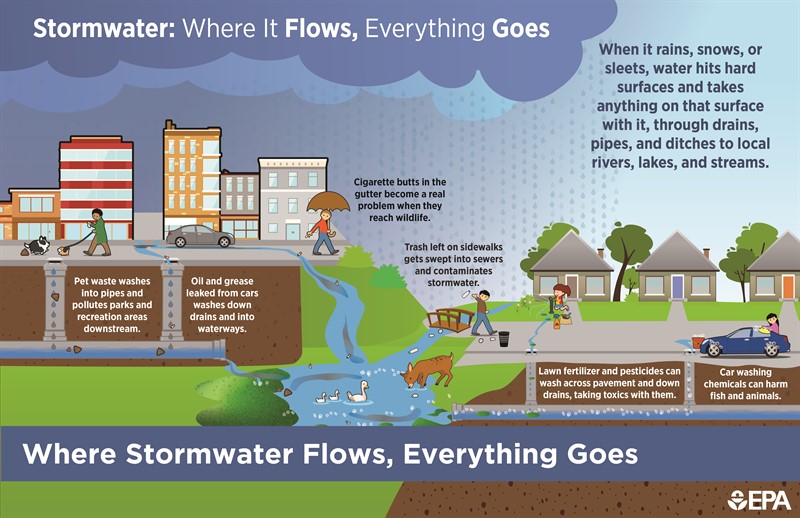

Stormwater 101
From our regulator and partner, the MN Pollution Control Agency (MPCA)Rain and melting snow create runoff as they move across the landscape to lakes, streams, rivers, and wetlands. In urban areas, most stormwater falls on streets, sidewalks, parking lots, roofs, and other hard surfaces and carries pesticides, fertilizers, oils, metals, salt, bacteria, litter, yard waste, sediment, and other materials down storm drains and into lakes and streams. Unlike wastewater, most stormwater is not treated at a facility before it empties into nearby bodies of water. Not surprisingly, stormwater runoff is a leading source of water pollution.
In addition to the contaminants it carries, stormwater runoff from hard, urban surfaces travels faster and in large quantities, the force of which damages rivers, streams and wetlands and can destroy habitats for fish and other aquatic life. Impervious surfaces also prevent stormwater from filtering into the ground and recharging groundwater.
A public entity’s stormwater system (ditches, stormwater ponds, curbs and gutters, storm drains, catch basins, storm sewer pipes, and so on) is called a Municipal Separate Storm Sewer System (MS4). (This does not include systems where wastewater and stormwater are combined.)
The MPCA regulates MS4 systems as mandated by the federal Clean Water Act with the goal of improving water quality by reducing pollutants in stormwater discharges. MS4 regulations require that owners/operators educate citizens on stormwater management issues and include them in solving stormwater problems, make plans to detect and stop illicit discharges, control runoff on construction sites, and more.
Current challenges in stormwater
In most towns and cities, there’s a storm drain on almost every street corner. That’s a lot of openings to the storm sewer—a direct path to lakes and streams. So keeping contaminants out of stormwater requires effort from everybody: keeping leaves and grass clippings away from curbs, using phosphorus-free lawn fertilizer, picking up litter when you see it, and directing your rain gutters onto your lawn or into a rain barrel. Some of the larger challenges include:
Chloride (salt). The salt applied to roads, parking lots, and sidewalks during our icy winters contains chloride, a water pollutant. When snow and ice melts, the salt goes with it, washing into storm drains and then lakes and rivers. It takes only one teaspoon of road salt to permanently pollute five gallons of water. Once in the water, there is no way to remove the chloride, and at high concentrations, chloride can harm fish and plant life.
Lawn care practices. Homeowners use up to 10 times more chemical pesticides per acre on their yards than farmers use on their crops, according to the U.S. Fish and Wildlife Service. A lot of that fertilizer will end up in stormwater. Unraked leaves get into the gutter. Patios and driveways add to the hard surfaces over which stormwater runs, rather than soaking into the ground. Video tips for reducing pollution and having a greener lawn!.
Click here for a short animated video of Stormwater and why it is important!